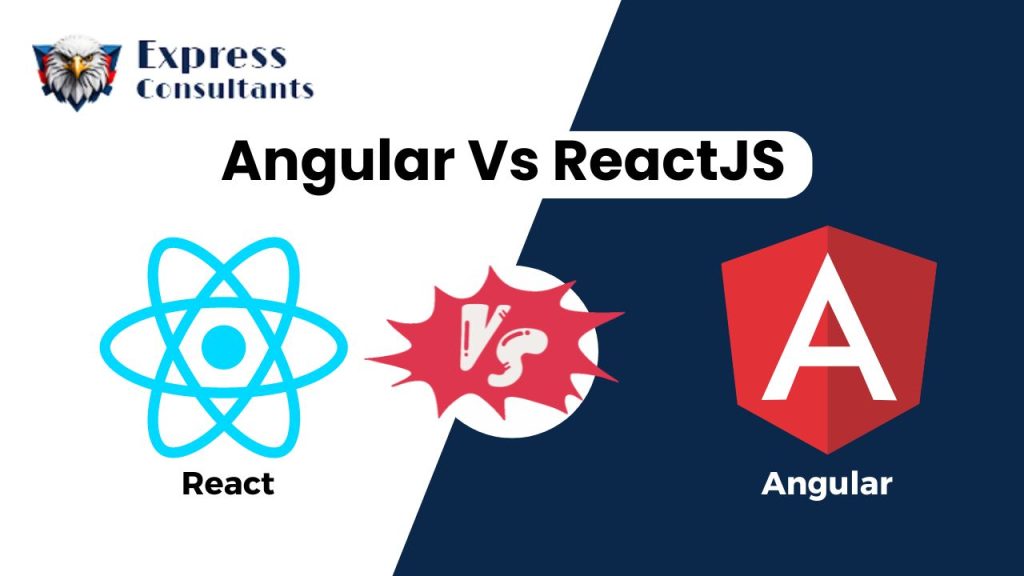
Angular vs ReactJS: Which One is Better for Frontend Development Framework in 2024?
September 30, 2024Angular vs ReactJS: Which One is Better for Frontend Development Framework in 2024?
JavaScript frameworks are still the lifeblood of frontend development, and Angular vs ReactJS is one debate that refuses to die down. If you’re dipping your toes into web development or are a seasoned developer planning your next project, this decision can be a game-changer. Whether you’re a fan of Angular’s full-fledged ecosystem or ReactJS’s simplicity and flexibility, it’s clear that both have their strengths and weaknesses. But, which one’s better for frontend development in 2024? Let’s break it down.
What is Angular?
Angular is a full-fledged frontend development framework that’s been around since 2010, developed and maintained by Google. It’s designed to create dynamic, single-page applications (SPAs) and boasts a rich set of features right out of the box. Angular uses TypeScript (a superset of JavaScript) and follows a very opinionated and structured approach to building web apps.
You get everything you need and then some—routing, form validation, dependency injection—you name it, Angular’s probably got it baked in.
- Component-based architecture that promotes reusability.
- Two-way data binding to automatically synchronize the model and view.
- A huge community and support from Google make it a reliable choice for enterprise-grade applications.
What is ReactJS?
ReactJS, on the other hand, is more of a library than a framework. It was created by Facebook in 2013 to make UI development easier and more efficient. Instead of offering a complete package like Angular, React focuses on building user interfaces and lets you decide what other tools you want to pair with it.
React is all about components too, but it’s lightweight and allows you to have more control over how you structure and build your application.
- Virtual DOM that enhances performance by minimizing direct manipulation of the DOM.
- Unidirectional data flow, making debugging easier and more predictable.
- Highly flexible, allowing developers to integrate with other libraries or even frameworks for state management, routing, etc.
Pros and Cons of Angular and ReactJS
Both Angular and ReactJS have their advantages and shortcomings. Let’s dig deeper into each:
Angular: Pros
- Complete framework: Everything’s in one place, making it perfect for large-scale applications.
- TypeScript support: Reduces bugs and enhances productivity with static type checking.
- Two-way data binding: Syncs your data between the model and the view instantly.
- Comprehensive documentation: Detailed resources for developers to dive into any topic they’re curious about.
Angular: Cons
- Steep learning curve: Angular’s rich feature set makes it complex, especially for beginners.
- Verbosity: It can feel a bit heavy-handed with boilerplate code and configuration.
- Slower performance compared to React when handling small to medium-sized applications.
ReactJS: Pros
- Flexibility and simplicity: You’re in control of the development stack, which allows for fine-tuned, highly-optimized applications.
- Fast rendering: The virtual DOM makes React apps highly efficient, particularly in complex applications.
- Reusable components: React’s emphasis on components leads to cleaner, more maintainable code.
- Great ecosystem: Tons of community-driven libraries like Redux, React Router, etc., to extend its functionality.
ReactJS: Cons
- Not a full framework: You’ll need to rely on third-party libraries for things like routing and state management, which can add complexity.
- Poor documentation: The rapid pace of React’s development means documentation often lags behind.
- JSX syntax: Mixing HTML with JavaScript (JSX) can be off-putting for some developers.
Angular vs ReactJS: Which One is Better for Frontend Development Framework in 2024?
This might seem like a trick question because the answer really depends on what you need for your project. Angular and ReactJS both have their sweet spots, and here’s where things start to get interesting. In 2024, developers still face this choice based on project needs and the development team’s expertise.
| Angular vs ReactJS Main Difference | ||
| Angular | ReactJS | |
| Type | Full-fledged framework, offering a complete solution | JavaScript library focused on building user interfaces |
| Language | Built with TypeScript, providing static typing | Built with JavaScript, with optional TypeScript support |
| Learning Curve | Steeper learning curve due to its complexity and extensive features | Easier to learn for beginners, especially with JavaScript knowledge |
| Data Binding | Two-way data binding, automatically syncing data between model and view | One-way data binding, making data flow predictable and easier to debug |
| Performance | Can be slower for small to medium-sized applications due to its complexity | Virtual DOM improves performance, especially in dynamic or complex UIs |
| Flexibility | Highly opinionated with many built-in features, which may limit flexibility | Extremely flexible, allowing developers to choose the tools and libraries they need |
| Community Support | Large community with official support from Google, making it reliable for enterprise applications | Strong open-source community with extensive resources, backed by Meta (formerly Facebook) |
| Use Cases | Best suited for large, enterprise-grade applications with complex features | Ideal for smaller, dynamic, or single-page applications where performance and simplicity matter |
| State Management | In-built with RxJS and NgRx for handling state in complex apps | External libraries like Redux or MobX are often used for state management |
| Ease of Testing | Testing is integrated into the framework with tools like Jasmine and Karma | Requires additional libraries for testing, such as Jest or Enzyme |
When to Choose Angular
- Enterprise-level applications: Angular shines when you need a robust, all-in-one solution for large-scale apps with complex features. Think banking systems, CRM software, or apps where consistency and scalability are crucial.
- TypeScript-first development: If your team prefers a strict typing system or has experience with statically typed languages like Java or C#, Angular, with its baked-in TypeScript, is the way to go.
- Team structure: For projects with larger teams, Angular’s standardized structure helps maintain uniformity across the board. With predefined rules and conventions, onboarding new team members becomes easier, reducing the learning curve over time.
When to Choose ReactJS
- Single-page applications (SPAs): React’s flexibility makes it ideal for SPAs where you don’t need a full-fledged framework. It gives you freedom without the baggage of a heavier tool like Angular.
- Smaller or mid-size projects: If you’re building something lightweight that doesn’t require all of Angular’s built-in features, React is much more agile and simpler to use.
- Customizable ecosystem: Need total control over the libraries you’re using for things like state management and routing? React’s flexibility gives you the freedom to pick and choose, so you can craft an ideal stack for your needs.
- Fast learning curve: For newer developers or teams, React’s simplicity and the abundance of learning resources make it a quick pick-up.
Conclusion
So, Angular vs ReactJS—who’s the winner? Well, it depends, Angular’s your go-to for large, enterprise applications that need a complete solution with minimal external dependencies. ReactJS, however, excels in flexibility and performance, making it perfect for modern, dynamic user interfaces, particularly in smaller applications.
Ultimately, the better choice for frontend development in 2024 comes down to the project’s needs and your team’s expertise. If you’re still unsure, it might even make sense to learn both; they each bring something unique to the table.
In the end, the real question isn’t Angular vs ReactJS, but rather—what suits your project better in 2024?
You may also like :-
- Kotlin vs Flutter: Which One is Better in 2024?
- E-commerce Website Development: Why It’s More Important Than Ever
FAQs: Angular vs ReactJS
1. Which is easier to learn: Angular or ReactJS?
Well, that really depends on your background. If you’re already familiar with TypeScript and enjoy a more structured framework, Angular might not be too bad. But for most beginners, ReactJS is way easier to get started with. It’s more flexible, and because it’s just a library, you don’t have to worry about learning a ton of built-in features right away. Plus, there are loads of resources online for React.
2. Does Angular or ReactJS who perform better for large-scale apps?
For large, enterprise-level apps, Angular typically performs better, especially because it comes with everything you need right out of the box. You won’t have to scramble to find third-party libraries, and the strong community and Google’s support ensure stability. ReactJS can handle large apps too, but since it’s more lightweight, it’ll require additional tools and libraries, which could complicate things.
3. Can I use TypeScript with ReactJS?
Even though ReactJS is based on JavaScript, it fully supports TypeScript. In fact, many developers love combining React with TypeScript for the extra type safety and debugging ease. So, if you like Angular for TypeScript but prefer React’s flexibility, you can have the best of both worlds.
4. What’s the main difference between Angular and ReactJS?
The main difference is that Angular is a full-fledged framework, while ReactJS is a library. Angular gives you everything from routing to state management built-in, which can be handy if you like an all-in-one solution. ReactJS is more flexible— it lets you pick and choose the tools you want to use, but that means you have to configure more yourself.
5. Which one is better for mobile app development?
For mobile development, ReactJS has a bit of an edge because of React Native. React Native allows you to build cross-platform apps using React, so it’s super efficient if you want a mobile version of your web app. Angular has options like Ionic, but React Native is often considered more popular and powerful in the mobile space.
6. Can you use Angular and ReactJS together in a project?
Technically, yes, but why would you want to? They’re built to handle the same kinds of tasks, so combining them would only add unnecessary complexity. It’s best to pick one and stick with it for the duration of your project.
7. Which one should I learn first in Angular or ReactJS?
If you’re just starting out, ReactJS is probably the better bet. It’s simpler, and there’s a huge community of developers who’ve been in your shoes. But if you’re planning on building large, enterprise-level apps, learning Angular could be a smart investment. The best choice depends on your goals and the kind of projects you’re interested in.
Ready to unlock your business's potential with custom software
Contact Us


